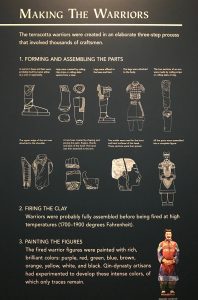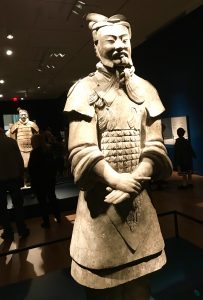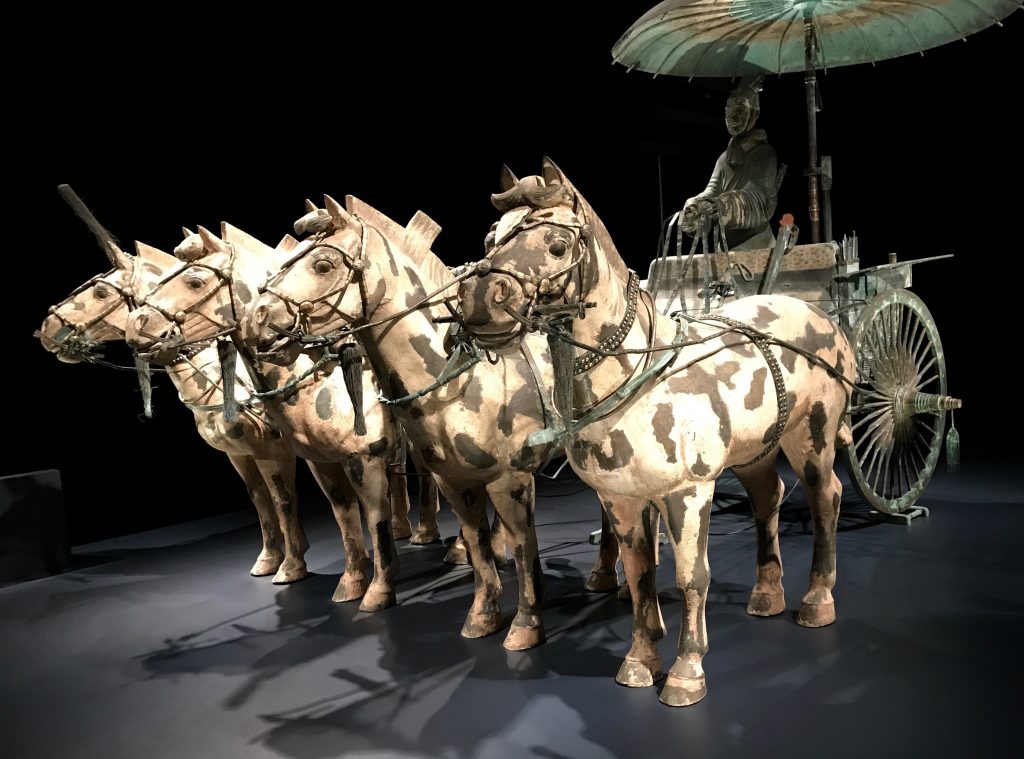 Send to Kindle
Send to KindleAs I mentioned in my last post, I declare one day a week, MY DAY. A few of weeks ago I took myself on a date to see The Terracotta Army on exhibit at the Virginia Museum of Fine Arts, in Richmond, about an hour away from my home. It’s a great museum and I’ve been fortunate to have seen several great exhibitions there, including Chihuly’s exquisite work in glass. Bill came along and after we roamed through the exhibition halls, we had lunch with a friend we haven’t seen in a while at the museum’s fantastic restaurant, Amuse. The food is always superb and most often reflects on the theme of the major exhibition going on. This time was no exception with a menu filled with delicious sounding Chinese dishes.
 The exhibition itself is a small sampling of “terracotta sculptures depicting the armies of Qin Shi Hung, the first Emporer of China.” Life size, the beautifully restored figures of warriors, horses and chariots, were buried in 209-210 BCE near the Emporer’s mausolium to protect him in the Afterlife. Discovered in 1974 by farmers digging a well, were the figures of some 8,000 soldiers, 130 Chariots, and over 500 horses. Made by government workers and local craftsmen, the originals were put together from individual pieces built seperately. Then the torsos, heads, arms, and legs and were put together with more clay in a process called luting. The faces were made in molds and then more clay was added and sculpted to provide individual facial features.
The exhibition itself is a small sampling of “terracotta sculptures depicting the armies of Qin Shi Hung, the first Emporer of China.” Life size, the beautifully restored figures of warriors, horses and chariots, were buried in 209-210 BCE near the Emporer’s mausolium to protect him in the Afterlife. Discovered in 1974 by farmers digging a well, were the figures of some 8,000 soldiers, 130 Chariots, and over 500 horses. Made by government workers and local craftsmen, the originals were put together from individual pieces built seperately. Then the torsos, heads, arms, and legs and were put together with more clay in a process called luting. The faces were made in molds and then more clay was added and sculpted to provide individual facial features.
It was a great experience to see theses phenominal sculptures and to imagine how they must have looked when discovered in the pits in which they were buried. I am fascinated by this army of clay figures, how they were made, and the ancient funerary practices of so many past civilizations as they prepared for death. I am left to wonder if we should be disturbing and taking the art from these sacred burial sights or should we leave them out of respect for those who created them.
I am also curious about what humans in the very distant future will discover about our current  civilization when they dig deep into the earth looking for hints about who came before them. What will our landfills tell them when they uncover the remains of our Golden Arches or the bits and pieces of what might be considered primitive robotic intelligence. Or will all bits and pieces of us disspear into the dust of centuries?
civilization when they dig deep into the earth looking for hints about who came before them. What will our landfills tell them when they uncover the remains of our Golden Arches or the bits and pieces of what might be considered primitive robotic intelligence. Or will all bits and pieces of us disspear into the dust of centuries?
What do you think?


Thank you for taking us on this fascinating tour of the Terracotta exhibit, Joan. It does beg the question you ask about what future generations will discover about us especially since a big part of our lives and communication occur online. All the more reason to step away for a “ me day” and explore the world around us.
Thanks, Kathy. Exploring the world is so very important. If we can’t travel for whatever reason, exhibits like this one help us see what we’re missing. Without exploring in whatever way we can our own identities are lost to us and we find ourselves in a vacuum.
Joan — Oh my gosh, thank you for the virtual tour. How cool is that?!
Laurie, I’m glad you enjoyed it. I hope you’ll have a chance to see it for yourself one day.
When I taught at Florida State College, I got to see Chihuly’s exquisite glass work. And when I attend openings at MOCA, Jacksonville’s Museum of Contemporary Art, the appetizers are often themed from the artist’s country of origin. I do remember twisty pretzel treats when a German sculptor was featured.
Yay, for Me Day! I’m overdue for one.
Marian, Be sure take a ME DAY soon! You deserve it!